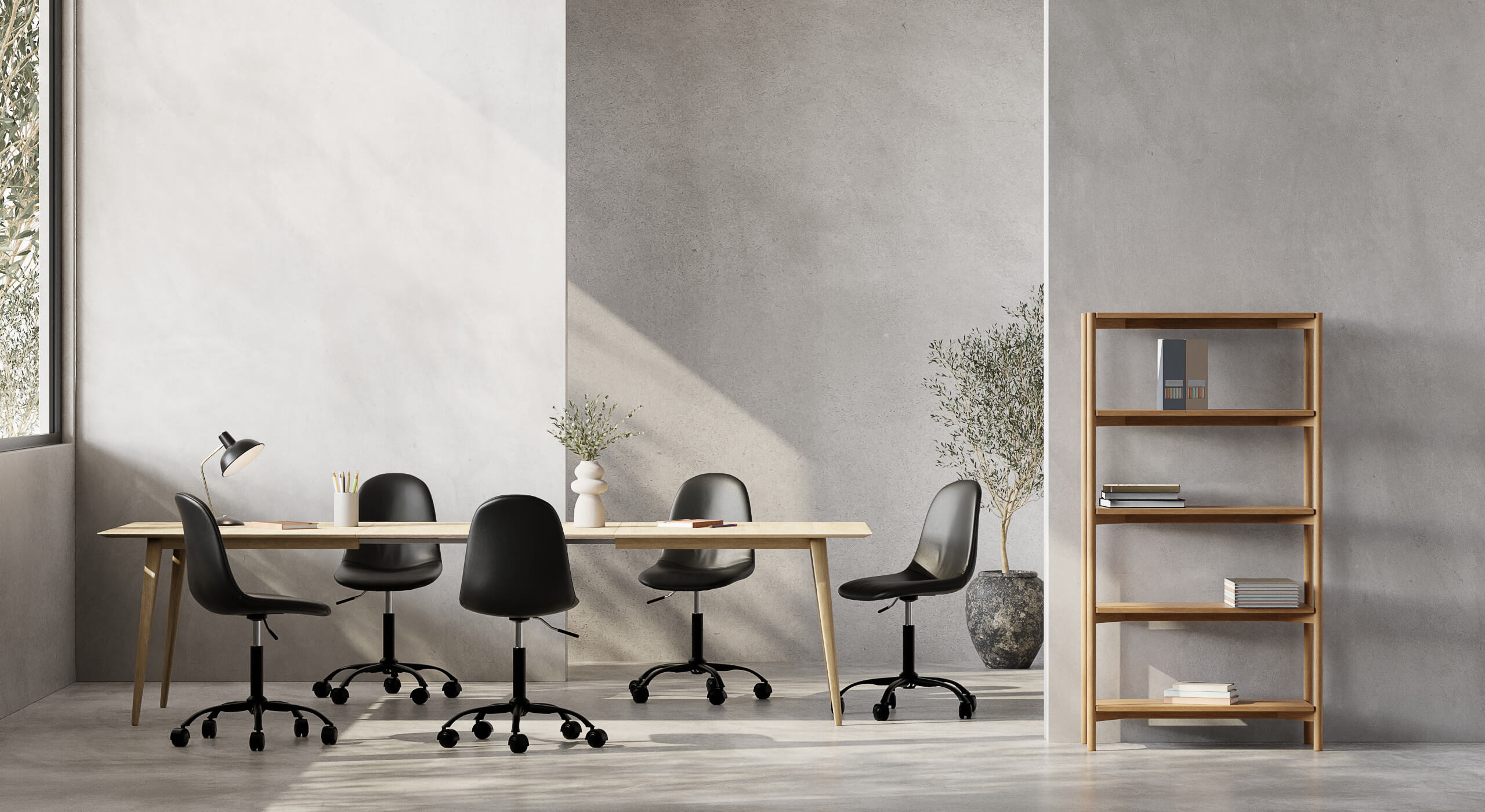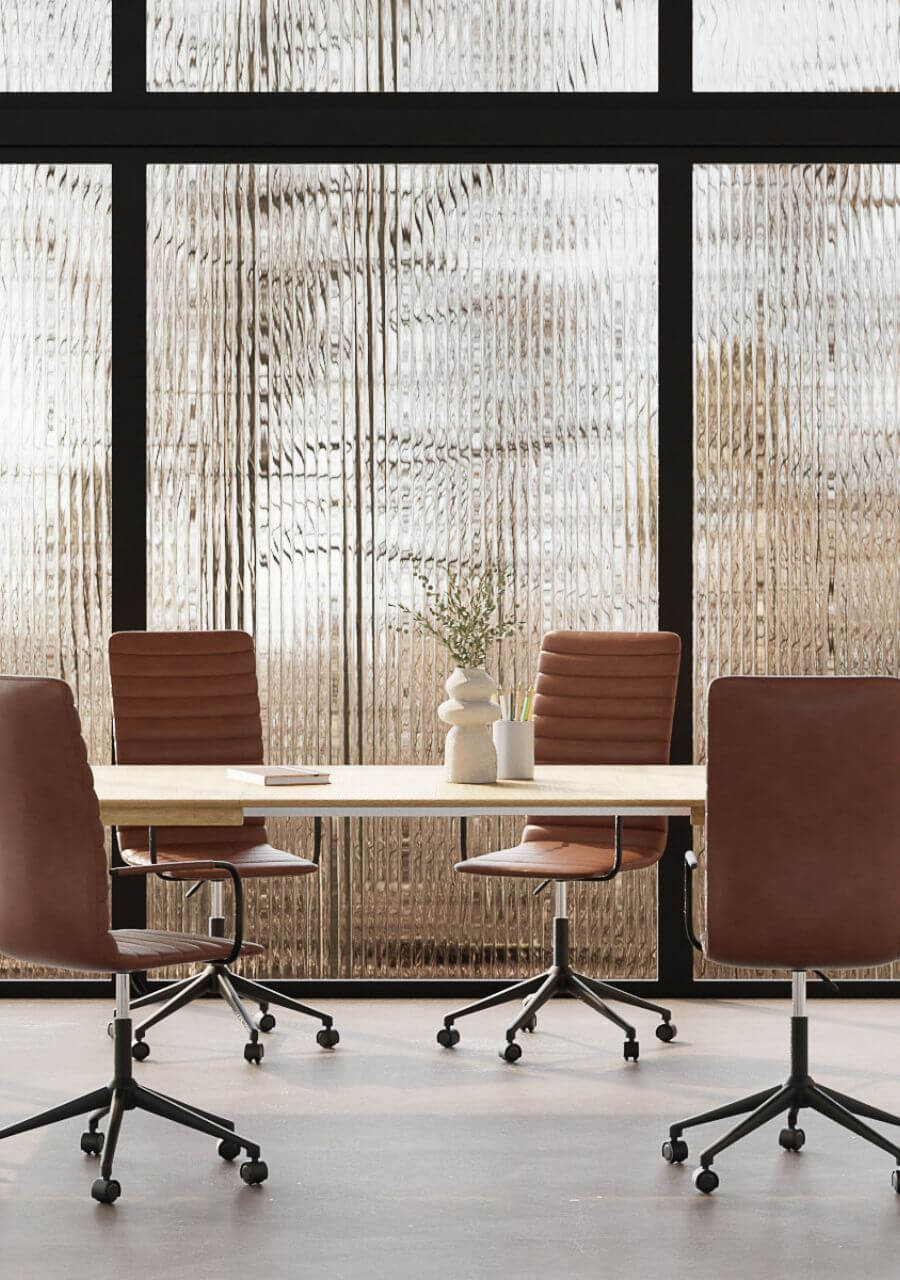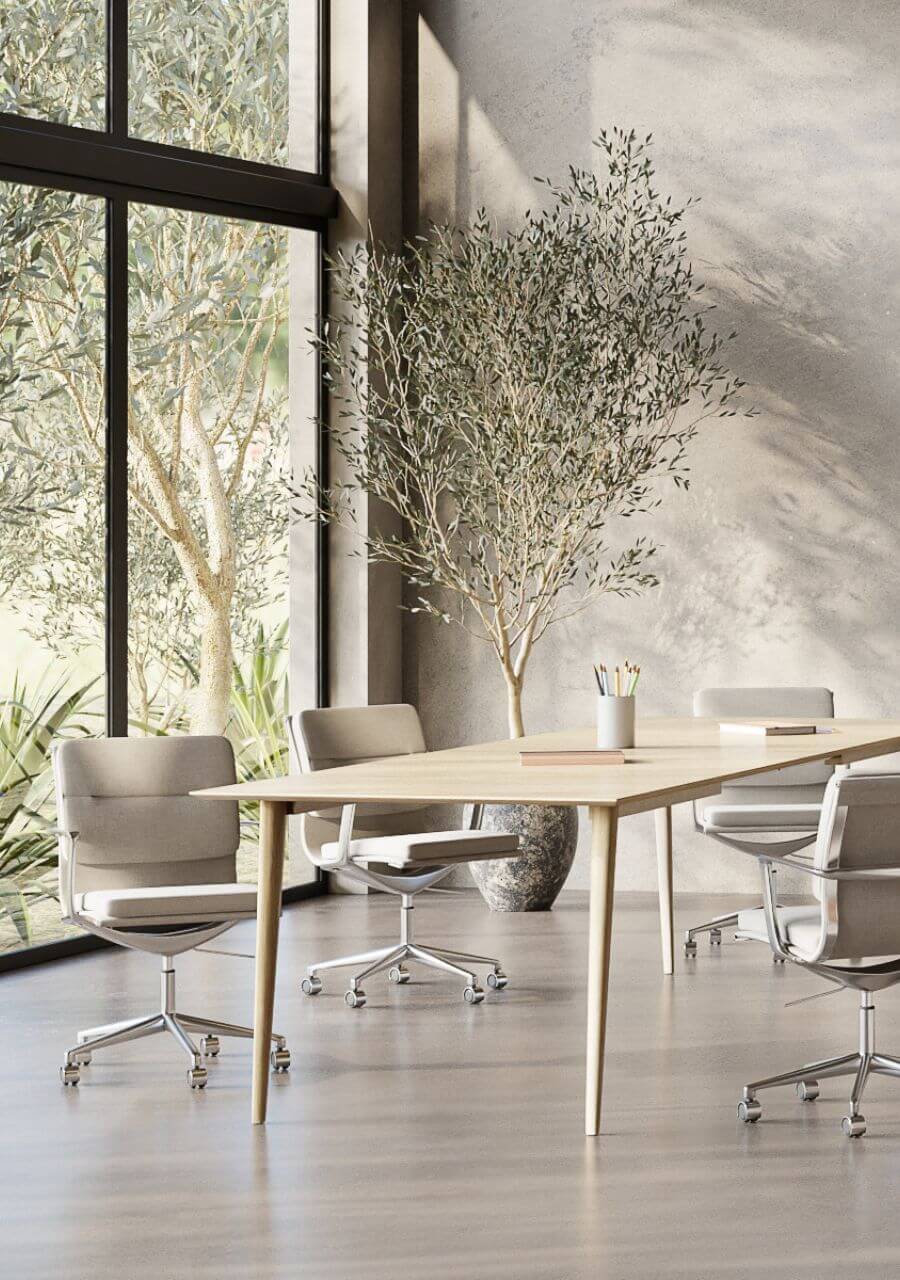
Choosing the right office chair is more than just picking a seat - it's about comfort, design harmony, functionality, and durability. Whether you're designing a home office, outfitting a corporate space, or leading an interior project, selecting the perfect office chair requires consideration of multiple factors. This guide will help you understand the essential aspects of choosing the right office chair tailored to both your style and practical needs.


1. Understanding the Purpose of the Office Chair
When choosing an office chair, it's important to start by clearly understanding its intended purpose. Consider whether the chair will serve as your main seat for long hours of desk work, be used occasionally by guests or clients, or act as a design statement in an executive space. Each of these scenarios comes with distinct needs and priorities. A chair meant for extended computer use, for instance, should offer ergonomic support, adjustable features, and all-day comfort to promote good posture and prevent fatigue.
In contrast, chairs designated for guest seating may focus more on aesthetics and space-saving design, providing enough comfort for short-term use without the complex features of a task chair. Executive chairs, meanwhile, often combine high-end materials and visual impact with comfort, projecting authority and professionalism. Understanding how the chair will be used allows you to focus on the right features and avoid unnecessary costs or compromises, ensuring the chair effectively supports its role in your workspace.


2. Types of Chair Bases: Wheel vs Fixed
The type of base on an office chair plays a significant role in both its functionality and visual appeal. Wheel base chairs, also known as caster chairs, provide flexibility and ease of movement, making them ideal for fast-paced or multitasking work environments. In open-plan offices, shared workspaces, or compact home offices, a wheeled base allows users to slide between desks, reach for supplies, or engage with coworkers without having to stand up repeatedly. This mobility can enhance workflow efficiency and reduce physical strain during frequent movement.
Conversely, fixed base chairs - those without wheels - offer a more stable and sophisticated presence. These chairs are commonly used in formal settings such as conference rooms, executive offices, or reception areas where mobility is less critical and a sleek, professional look is preferred. Fixed bases also prevent unintended movement, which can be beneficial in situations where focus and posture are paramount. When deciding between the two, consider how the space is used day-to-day, the level of movement required, and the overall aesthetic you want to maintain in the room.
Almost all of the office chairs we offer feature a stainless steel base, whether wheeled or fixed. This ensures long-term durability, resistance to corrosion, and a clean, modern appearance across our product range. Stainless steel adds strength and value to your chair, making it suitable for both high-traffic workspaces and refined executive settings. Its sleek finish complements nearly any design scheme - from industrial and minimalist to classic corporate - offering the perfect balance of practicality and style.
3. Material Options: Style Meets Function
Leather Office Chairs
Leather office chairs are the epitome of elegance and longevity, making them a staple in refined or formal work environments. Crafted from genuine leather, these chairs exude sophistication and authority - ideal for executive offices, boardrooms, or client-facing areas where aesthetics and first impressions matter. Beyond their luxurious appearance, leather chairs offer exceptional durability, aging gracefully and developing a rich patina over time. They resist daily wear and tear better than many materials, making them a long-term investment in both style and function. Available in classic shades like black, deep brown, or tan, they seamlessly blend with traditional wood furnishings or modern minimalist designs. While they do require occasional conditioning to maintain their supple texture, the result is a professional seating option that delivers prestige, comfort, and performance in equal measure.
Want a chair that exudes prestige and lasts for years? Explore our leather office chairs →
PU-Leather Office Chairs
PU-leather office chairs are a smart, budget-friendly alternative for those who appreciate the look of leather but prioritize affordability and practicality. Made from a synthetic polymer that mimics the appearance of genuine leather, PU leather is smooth, uniform, and available in a wide range of colors and styles. It’s notably lighter and more flexible, making PU chairs easier to move and maintain - ideal for fast-paced, dynamic environments like home offices, co-working spaces, or tech startups. These chairs are also resistant to spills and stains, requiring only a quick wipe-down for cleaning, which makes them perfect for everyday use. Though they don’t develop the patina of real leather, PU-leather chairs offer a contemporary aesthetic and comfort at a lower cost, striking a balance between visual appeal and functional design.
Looking for the leather look without the high price tag? Explore our PU-leather options →
Fabric Office Chairs
When selecting an office chair, fabric is a versatile material that balances comfort and style. Known for its breathability and softness, fabric is a smart choice for settings where people remain seated for extended periods - such as creative studios, co-working spaces, or home offices designed for everyday use. With a wide array of colors and textures available, fabric chairs can easily match casual or personalized interior styles. However, since fabric is more prone to staining and can be harder to clean, it's best to opt for high-quality, stain-resistant options in busy or high-traffic environments to ensure durability without sacrificing comfort.
Need breathable, all-day comfort? Explore our fabric office chairs →
Velvet Office Chairs
For those seeking to make a bold and luxurious design statement, velvet office chairs offer a distinct touch of elegance. With their plush texture and rich color choices, velvet chairs are perfect for boutique studios, design-forward home offices, or creative executive spaces looking to blend artistry with professionalism. While velvet requires more maintenance to keep its appearance pristine, its visual impact and tactile appeal make it an excellent choice when aesthetics are a top priority. A velvet chair can easily become the focal point of a room, adding character and sophistication to any workspace.
Craving comfort with a luxe touch? Explore our velvet office chairs →


4. Matching the Chair to Your Interior Style
An office chair isn’t just a functional piece—it’s also a key element of your workspace’s overall aesthetic. Choosing a chair that harmonizes with your interior style helps create a cohesive, visually pleasing environment. Start by identifying the dominant design theme in your space, whether it's minimalist, contemporary, traditional, or something in between. The right chair can either blend seamlessly into the background or serve as a stylish focal point, depending on your goals.
For minimalist interiors, less is more. Chairs with clean lines, streamlined silhouettes, and neutral tones such as white, black, or gray are ideal. Materials like PU leather or plastic contribute to a sleek, clutter-free look while offering practical benefits such as easy maintenance. These chairs are perfect for modern home offices, tech-focused environments, or workspaces that favor simplicity and function over ornamentation.
If your space leans contemporary or traditional, you have more room to play with texture, color, and form. In contemporary offices, fabric or velvet chairs with chrome or matte black bases can create striking contrast and add sophistication. These materials pair well with bold colors or geometric design elements. For traditional or executive-style interiors, genuine leather chairs in deep tones like espresso or chestnut are a timeless choice. Look for details like tufting, curved arms, or high backs that echo classic design features, offering both comfort and a sense of authority.
5. Space Considerations
When selecting an office chair, it's essential to factor in the size and layout of your workspace. A chair that fits beautifully in one setting may feel overwhelming or impractical in another. Begin by measuring the available floor space, especially in areas where other furniture like desks, cabinets, or shelving units already occupy room. Consider how the chair will function in relation to these items—will it need to slide under a desk, swivel around, or tuck away when not in use?
In smaller or shared spaces, opt for chairs with a slim, compact design and minimal base structure. Armless models or those with low backs can help maintain an open, airy feel and avoid visual clutter. Chairs with a fixed base may also be preferable in tighter areas to prevent unnecessary movement and preserve floor space. These minimalist options are ideal for home offices, multi-use rooms, or co-working environments where flexibility and space-saving are priorities.
For larger offices or executive suites, you have the freedom to choose more substantial, feature-rich seating. High-back chairs with deep cushioning, adjustable armrests, and tilt mechanisms can enhance comfort during long work hours while making a strong visual statement. However, even in spacious rooms, it's important to ensure that there's adequate room for movement, especially if you're opting for a wheel base. Leave enough clearance behind and to the sides of the chair to allow smooth gliding, rotation, and repositioning without bumping into other furniture or walls.


6. Maintenance & Cleaning
When choosing an office chair, it's important to consider how much maintenance you're willing to commit to and what kind of wear the chair will experience. Each material comes with its own care requirements, and choosing the right one can save time and extend the life of your chair. If your workspace sees daily, high-volume use, or if you're outfitting a shared or commercial environment, durability and ease of cleaning should be a top priority.
Fabric chairs, while comfortable and breathable, tend to be more prone to stains and dust accumulation. They should be vacuumed regularly to prevent dirt from settling into the fibers, and spot-cleaned with a fabric-safe cleaner as needed. If you're placing fabric chairs in high-traffic areas, consider choosing stain-resistant or treated fabrics to make upkeep easier.
Leather and PU leather chairs offer a more maintenance-friendly option. Both can typically be cleaned with a soft, damp cloth and a mild cleaner. Leather should be conditioned occasionally to prevent drying or cracking, especially in climate-controlled spaces. For long-term care, consider using our dedicated leather and leatherlook care kits, which help preserve the material’s suppleness and sheen. PU leather, while lower maintenance, also benefits from regular gentle cleaning to maintain its appearance. Velvet chairs, while luxurious and visually striking, require more delicate care. Use a soft brush to lift the pile and remove dust, and a gentle fabric cleaner for occasional touch-ups. To preserve the plush look and feel of velvet, avoid abrasive tools or harsh chemicals.
7. Top Mistakes to Avoid
When shopping for an office chair, it's easy to get caught up in aesthetics - but one of the biggest mistakes is choosing a chair based purely on its appearance. While style is important, especially in a well-designed space, comfort and ergonomic support should always be top priorities. A visually stunning chair that lacks proper lumbar support, cushioning, or adjustability can quickly lead to discomfort, fatigue, or even long-term strain - especially if you're spending hours seated each day.
Another common oversight is failing to consider the size and layout of the room. A chair that looks perfect online may feel oversized or cramped once placed in a small home office or shared workspace. Conversely, a minimal chair may appear underwhelming in a large executive setting. Always measure the available space and visualize how the chair will interact with surrounding furniture, particularly in terms of mobility and access.
Lastly, don’t overlook the relationship between the chair and your desk height. An improperly matched height can lead to poor posture, wrist strain, or shoulder tension. Make sure the chair’s height is adjustable or suits your desk’s dimensions so you can maintain a natural, ergonomic working position. Testing the chair with your actual desk setup - when possible - is the best way to avoid this mistake. Prioritizing comfort, functionality, and fit will help you make a decision you’ll be happy with in the long run.


Making the Right Choice: A Chair That Works for You
Choosing the right office chair is a thoughtful process that involves balancing style, comfort, and functionality. Whether you're drawn to the sleek simplicity of PU leather, the plush elegance of velvet, or the classic appeal of genuine leather, there’s a perfect option to match every interior style. Likewise, selecting between a mobile wheel base or a refined fixed frame depends on how the space is used. By considering both the practical needs of the user and the design vision for the space, you can confidently select a chair that enhances both form and function.
It's also wise to factor in long-term value when making your decision. Setting a budget early on can help streamline your options, but it’s important not to prioritize cost over quality - especially if the chair will be used daily. Investing in high-quality materials, such as real leather paired with a stainless steel base, can offer superior durability, comfort, and aesthetic appeal. While the upfront cost may be higher, the extended lifespan and visual impact often make it a worthwhile investment for your office or interior project.
Ultimately, the right chair will support more than just your posture - it will support the way you work, feel, and present your space. Take the time to consider all aspects, from material care to room size, and you'll find a piece that brings both style and substance to your environment.
FAQs
1. Is PU leather good for long hours of sitting?
Yes, especially if combined with ergonomic features. It’s comfortable, stylish, and easy to maintain.
2. Are wheel base chairs better than fixed base ones?
It depends on use - wheel base is great for mobility; fixed base adds stability and aesthetic value.
3. What’s the most durable office chair material?
Leather and PU leather are highly durable; paired with stainless steel, they last for years.
4. Can I use velvet office chairs in a corporate setting?
Yes, especially in creative or boutique environments where luxury design is appreciated.
5. How do I match my office chair with my existing interior?
Consider color palette, materials, and design style. Choose neutral tones for flexibility or bold colors for accents.
 9000+ TRUSTPILOT REVIEWS
9000+ TRUSTPILOT REVIEWS


 EN
EN DE
DE FR
FR NL
NL DK
DK SE
SE